A Green Building Blooms in the Bronx
Air Date: Week of August 1, 2014
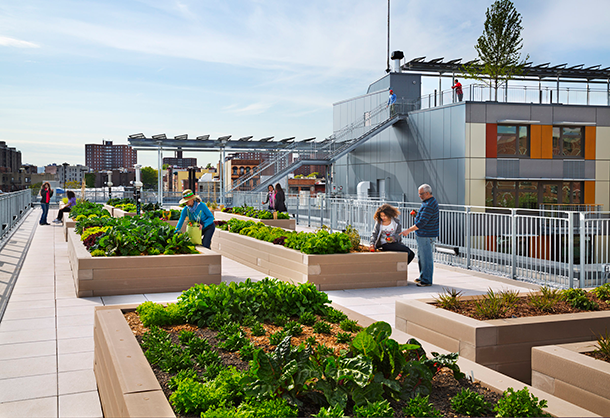
Via Verde’s roof houses garden beds for its residents. (Photo: David Sunberg; Courtesy of Jonathan Rose Companies)
Few think of affordable housing as a haven for nature in one of the toughest neighborhoods of New York City. But Via Verde, an energy efficient, garden-filled building in the South Bronx developed by the Jonathan Rose Companies and Phipps Houses, provides just that. Host Steve Curwood went to check it out.
Transcript
CURWOOD: Much of the South Bronx in New York City was burned out during the 1970’s and in this birthplace of hip-hop music there is still a lot of poverty and a lot of crime, especially in terms of assaults and thefts. So you might think it would be the last place an idealistic, sustainable housing developer would plunk down a LEED certified $100 million housing complex, but that’s exactly what Jonathan Rose did in 2012. Phipps Houses and the Jonathan Rose Companies won a design competition to create Via Verde, an affordable, energy-efficient, mixed-use housing development in the South Bronx, close to public transportation. We met Jonathan in his office in Manhattan.
ROSE: The design is fantastic. It enhances the neighborhood. It’s a very, very green design. The building is tall on the north side and steps down as it goes further south. We did that on purpose to bring in as much southern sunlight as we could into the building. We really tried to weave this fabric of green and nature and communal activity throughout the whole building. One of the things we did is we brought in Montifiore Hospital as a tenant, and partner really. And so they have created a community health center at the ground floor of the building. The building is very green, but it also has a theme of health that weaves through its entire being.
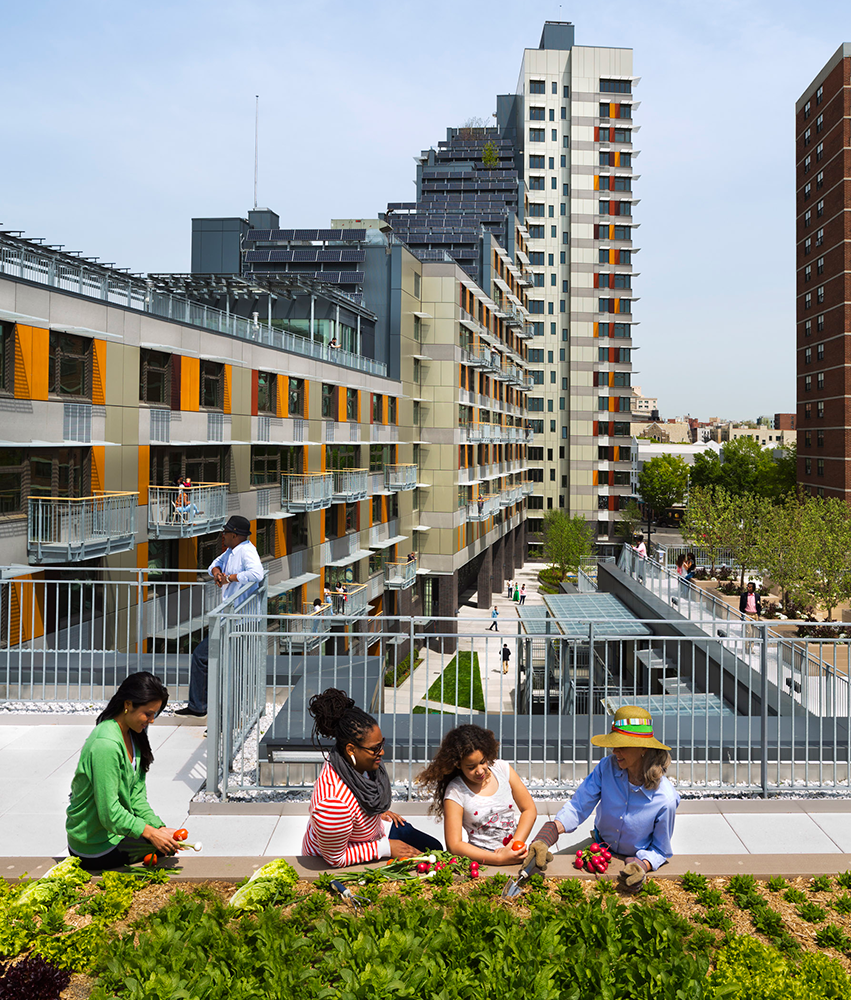
The energy-efficient affordable housing complex, Via Verde, uses solar power and gardens on its rooftop help owners and renters save money and live healthily. (Photo: David Sunberg; Courtesy of Jonathan Rose Companies)
CURWOOD: Via Verde means green way in Spanish, and that’s what strikes you when you walk in. There is grass and trees in a lush courtyard framed by a high-rise and a lower stepped building, where Living on Earth began its tour with architect Paul Freitag.
FREITAG: What I think the green way really is, if we want to start walking up a little bit, was this concept of recapturing the site that we’d be building the building upon, by actually creating a whole series of green roofs. As you visited these green roofs you’d actually be walking up through each of the gardens, and eventually you’ll end up all the way up on the seventh floor with a garden that’s right outside a fitness center.
CURWOOD: We’ve just come up the stairs -- to Christmas trees!
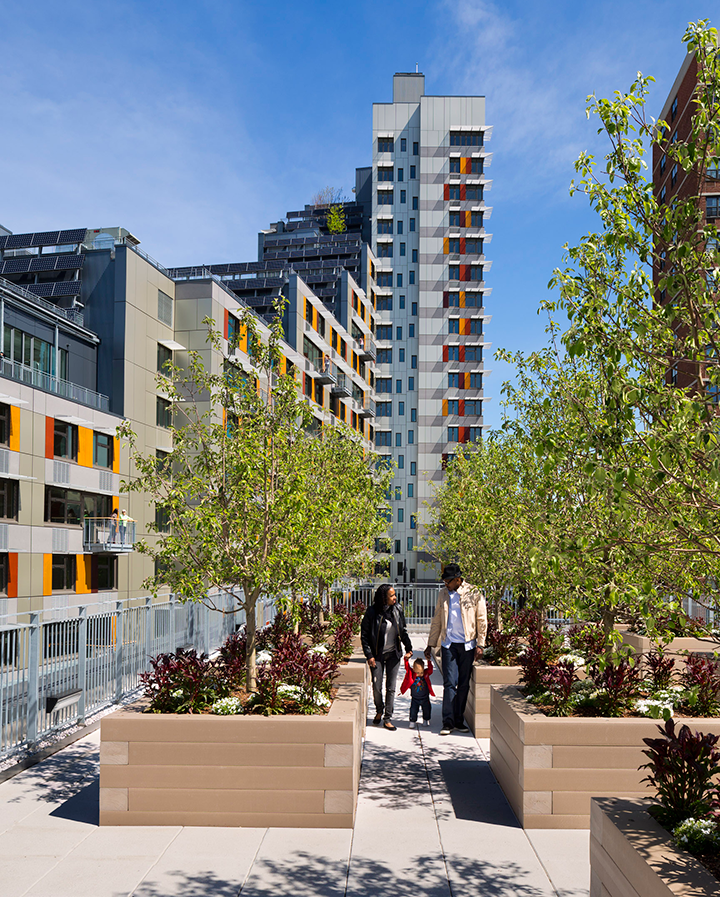
The South Bronx might be a rough area, but living in a space like Via Verde can help its residents rebuild a safer community. (Photo: David Sunberg; Courtesy of Jonathan Rose Companies)
FREITAG: Right, so the stairs we actually came up on aren’t stairs, that’s an amphitheater. And so at the base we actually have a children’s garden and then there’s this amphitheater that looks out over the garden. The amphitheater’s been used for movie nights, for concerts, for different community events within the building. But then you come up on the amphitheater. We’re now on top of the second floor and here, we have our Christmas Tree garden, and this is actually the site of events that the building sponsors in December, where the residents come and they actually make decorations and decorate the trees, and they sing carols.
CURWOOD: So now we’re headed up another level.
FREITAG: Right, so this next garden is our orchard, and what we have up here is actually 12 apple trees, and these trees all bear fruit. If we were to be here in September, October, you would see them filled with apples and they will bloom, and they will be beautiful. So all the planters are actually benches, and so you can sit under the trees. And this is just a wonderful, sort of space in which you enjoy the trees and also see the fruit that they produce.
[SOUNDS OF CLIMBING STAIRS]
FREITAG: So we head from here up to the roof of now the fourth level. It’s really the signature garden for the project. This is what we refer to as the “community garden.” And what we have up here, you’ll see are a whole series of planting beds that are planted by the Garden Club of Via Verde.
CURWOOD: A garden club in the South Bronx.
FREITAG: Yes, it’s a wonderful organization. One of the real goals here was to create an opportunity, for particularly children, to see food grow, take pride in growing fine fruits and vegetables, and really understand the alternatives for healthy eating in comparison to, you know, fast food and other options which unfortunately are often more available here in the South Bronx.
CURWOOD: So how many folks live here?
FREITAG: Well altogether it’s 222 units. I would guess that that translates to roughly between 400 and 500 people actually living here in Via Verde.
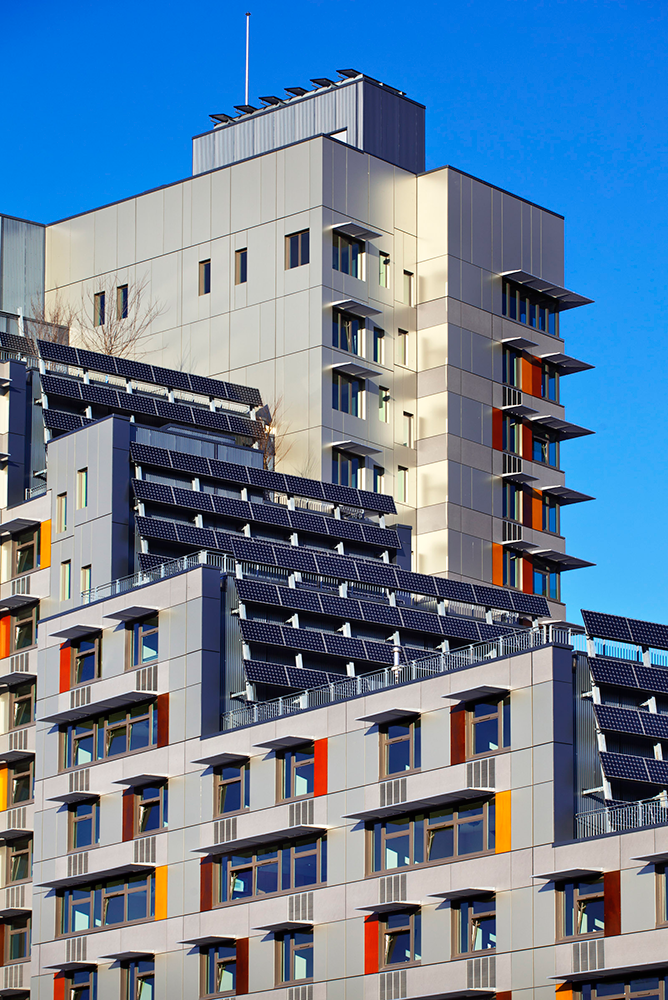
A façade of solar panels helps to capture the sun’s energy and power the Via Verde complex. (Photo: David Sunberg; Courtesy of Jonathan Rose Companies)
[WALKING UP STEPS]
FREITAG: So here we have our compost bins. And then here we also have our rainwater harvesting tanks. And as we walk up the next series of steps you’ll see how all of the south-facing walls of Via Verde actually have PV panels on them. At the entrance we actually have a readout panel that shows how much energy the building is generating at any point through its solar panels.
[FREITAG ENTERS CODE TO GET INTO STAIRWELL]
CURWOOD: So you have a sign here, by your stairs.
FREITAG: Right, so this is actually referred to as a stair prompt, these are generated by the New York City Department of Health. And it shows a sort of generic figure, I guess, very happily walking up the stairs and it says, “Burn calories, not electricity; take the stairs. Walking up the stairs for just two minutes a day helps prevent weight gain; it also helps the environment.” I think this sign in a very simple way shows the different strategies that you can use to have the building itself really promote the health of the residents.
CURWOOD: Penthouses are usually kept private for rich tenants, but the top floor of Via Verde is common space for anything from garden club meetings to receptions and birthday parties.
FREITAG: So here we are on the 20th floor and the views are spectacular.
CURWOOD: Whoa, look at this! You can see all the way over to the George Washington Bridge and downtown. Even the Empire State building sticks its head up and the new Trade Center building, is that possible to see? Yes it is, even, in the distance!
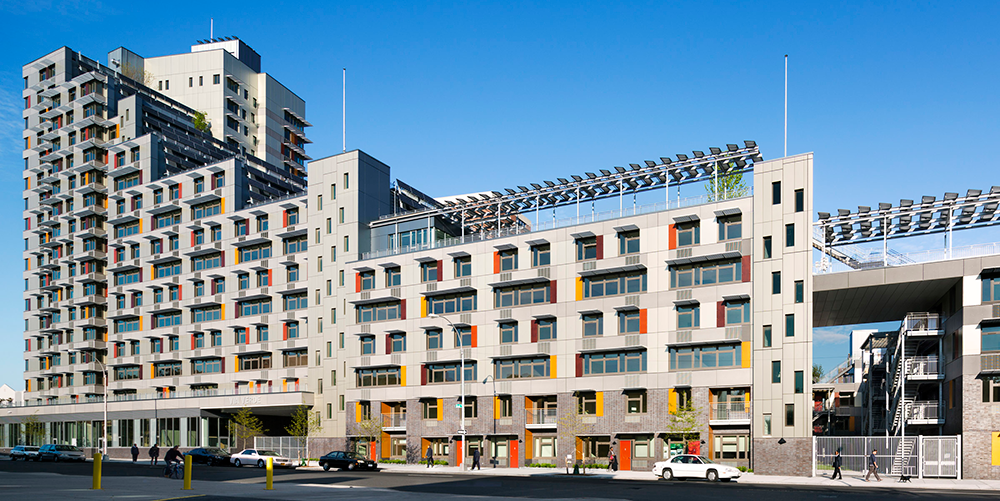
Many of the amenities on the outside of the building provide a service to Via Verde’s residents. (Photo: David Sunberg; Courtesy of Jonathan Rose Companies)
[SOUNDS OF DESCENDING STAIRS]
CURWOOD: We head back down stairs to meet one of the tenants.
FREITAG: Hi, Ms. Sanchez?
SANCHEZ: Yes.
FREITAG: Hi, I’m Paul Freitag from Jonathan Rose Companies.
SANCHEZ: Nice to meet you.
CURWOOD: Hi, I’m Steve Curwood, from Living on Earth, public radio program.
SANCHEZ: Have a seat!
CURWOOD AND FREITAG: Thank you.
CURWOOD: So, can I ask your name?
SANCHEZ: Dalia Sanchez
CURWOOD: And how long have you lived here?
SANCHEZ: I think I was one of the first ones to move in.
CURWOOD: Why did you pick this place?
SANCHEZ: I have lived in housing for more than 20 years and, you know public housing. The devastation there is horrible; the drug dealing was to die. And three months before they sent me my letter of acceptance, somebody got shot right in front of my door. So I said, “I think you need to go.” And here I am, two years later.
CURWOOD: So, what’s it like?
SANCHEZ: Wonderful. I have no complaints because every time I call, somebody comes around and takes care of it. You give them a complaint and they come. So it’s pretty good.
CURWOOD: So tell me about your unit, you have one bedroom here?
SANCHEZ: It’s a one bedroom; it’s huge and comfortable. I was taken aback, you know; one-bedroom apartments usually are tiny. My bedroom is huge! I got plenty of space. The bathroom is comfortable.
CURWOOD: Now, there’s got to be something that’s a problem here.
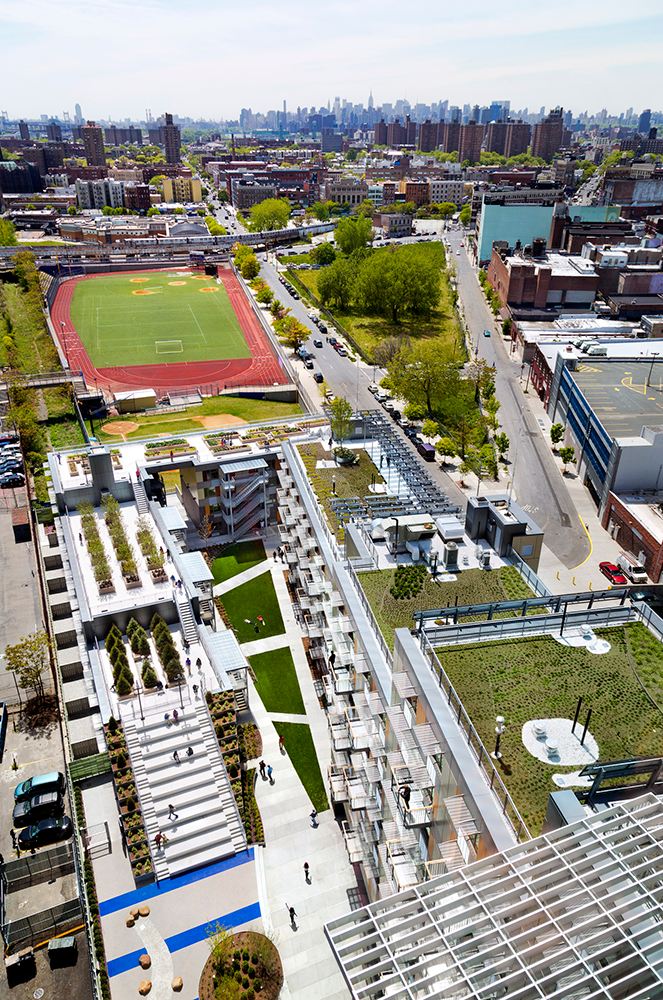
Via Verde overlooks the city of New York. (Photo: David Sunberg; Courtesy of Jonathan Rose Companies)
SANCHEZ: My only issue is that they came, and they took my Easter decorations last year. I was so angry. Then they come and take my Christmas decorations! But other than that, not a problem.
CURWOOD: Alright, well thank you very much. Very generous of you to open up your house like this.
SANCHEZ: Nice to meet you guys.
[ELEVATOR CHIMES]
CURWOOD: Back at the main entrance we meet a cheerful burly man who is busy accepting packages and checking to see that anyone who comes into the complex should be there.
ACEVEDO: My name is Julius Acevedo.
CURWOOD: How long have you worked here?
ACEVEDO: I’ve worked here for about a year. I’m the lead concierge.
CURWOOD: So what’s it like being concierge in the South Bronx?
ACEVEDO: Well, here it’s wonderful. The tenants here are terrific. The neighborhood is what it is, but we feel like we’re in a little bit of an oasis here, in the middle of the Bronx. This building is unique. We have owners and renters here, within the same facility. We’re all our own little community here; it’s phenomenal. The people love it, and I love working here. It’s just something different.
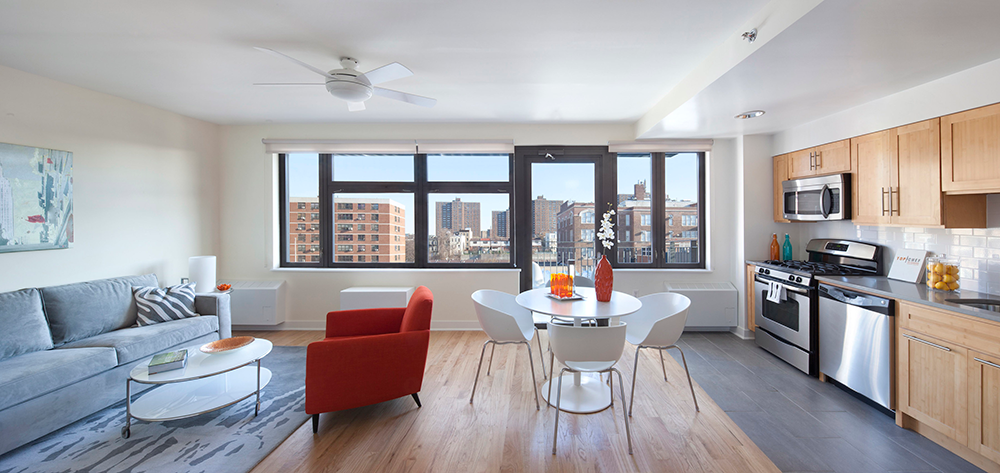
Inside a Via Verde apartment (Photo: Ruggero Vanni; Courtesy of Jonathan Rose Companies)
CURWOOD: Worst thing about it?
ACEVEDO: I haven’t found it! [LAUGHS] If there was a downside, I wish there were more units available for the community. I have an inordinate number of people coming in here every day wanting to rent or buy. And it’s just, we’re full; it’s 100 percent occupied.
CURWOOD: Thank you very much.
ACEVEDO: Thank you so much.
CURWOOD: Back at Jonathan Rose’s office in downtown Manhattan, he explains why he chose to develop a Via Verde in the South Bronx, famous for urban blight.
ROSE: The competition we won that led to Via Verde was led by Shaun Donovan, now the Secretary of HUD of the United States, then the Secretary of Housing of New York City. And he really wanted to see what was the best that could be done to advance community design, and to advance the greenness of design of affordable housing.
CURWOOD: How can green building help people of low and moderate income?
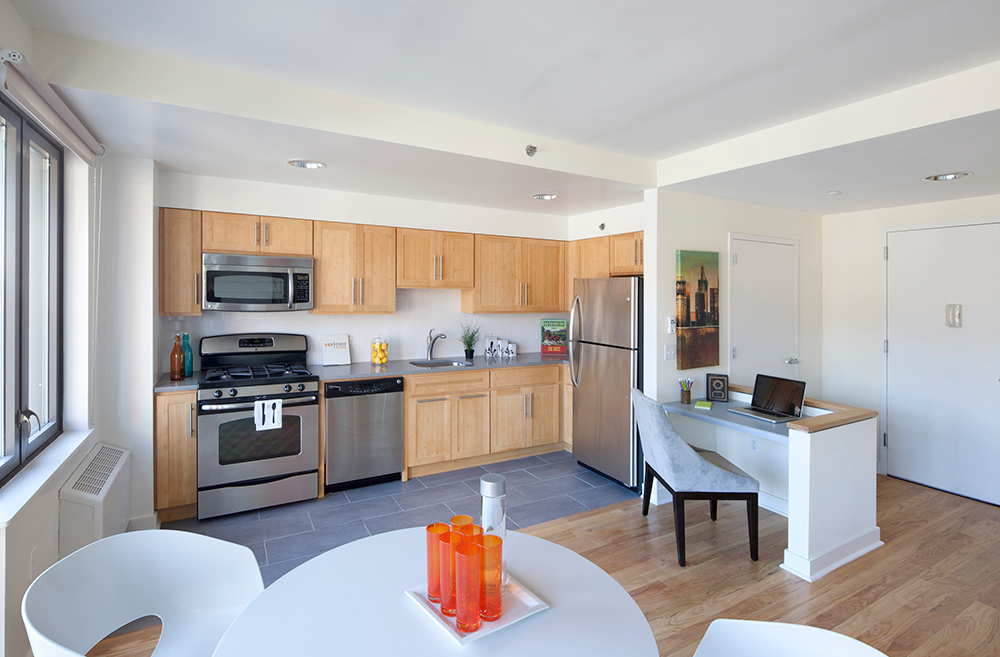
Via Verde’s apartments are designed with a theme of health and wellness in mind. (Photo: Ruggero Vanni; Courtesy of Jonathan Rose Companies)
ROSE: Energy savings of both location and energy efficiency have enormous economic benefits to our low-income and working class families. Much affordable housing is of poor quality. That’s one of the reasons why it’s affordable. And many of the tenants are responsible for paying the utilities. What we’ve learned is if you can create a green building that’s really well insulated, that’s caulked and weather-stripped, the utility costs can be cut in half or two-thirds. That has enormous impact to their bottom lines. That may be the difference between whether they can afford to send their kid to an after-school program or not, whether they can sign up for healthcare or not.
CURWOOD: What does the location in community, the space a building occupies, have to do with its environmental friendliness and public health profile?
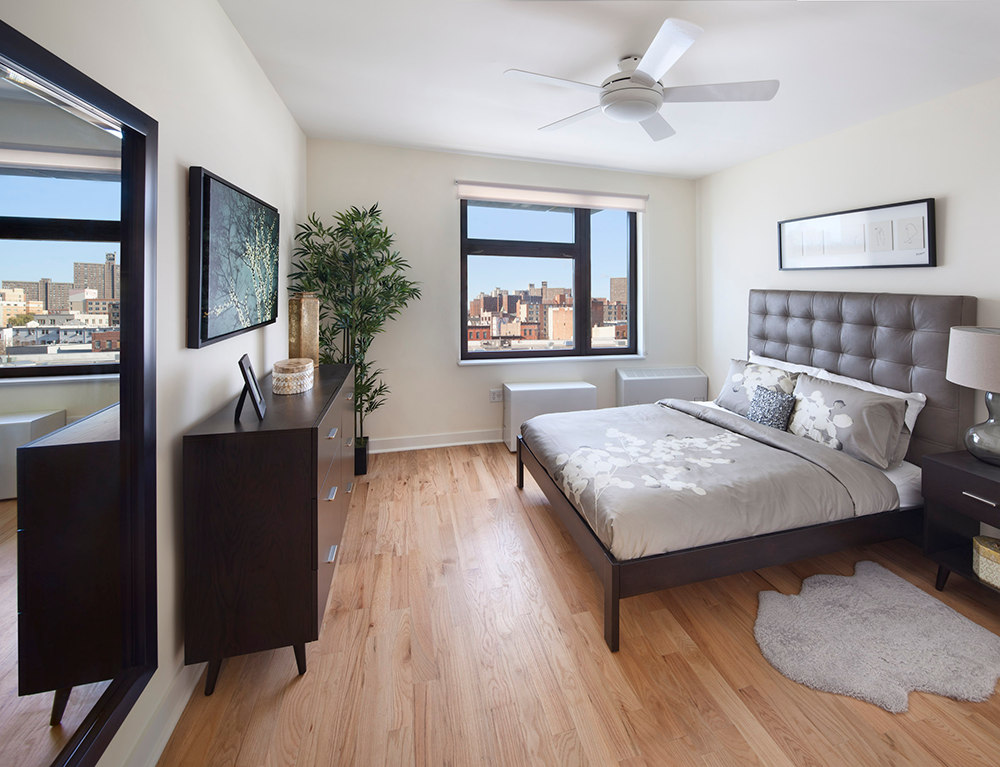
Apartments in New York are often small and cramped, but the one-bedroom units in Via Verde are spacious. (Photo: Ruggero Vanni; Courtesy of Jonathan Rose Companies)
ROSE: Locating buildings in denser communities with more services around them—such as schools nearby that kids can walk to, having mass transit that gives people easy and affordable access to jobs, to job training, to continuous education, to arts and culture—those have enormous social, communal, educational, and economic benefits. If a family lives in a city next to a subway line or a light rail line, or a bus line, it’s not only better for the environment but they personally are saving often $6,000, $7,000 or $8,000 a year. So one of the things that we’ve learned in creating great cities is how important social networks are. The people who now live there, they’re the ones who are gardening the building, creating events in the amphitheater. They’re the ones who have taken Via Verde and made it a real community. And so the building itself was just a well-conceived platform upon which they can then create the fulfillment of their lives.
CURWOOD: This is a time of great concern, whether it’s climate disruption, chemical exposure, unsafe streets. What can you in this world of green design do to respond to this rather deep anxiety in our society?
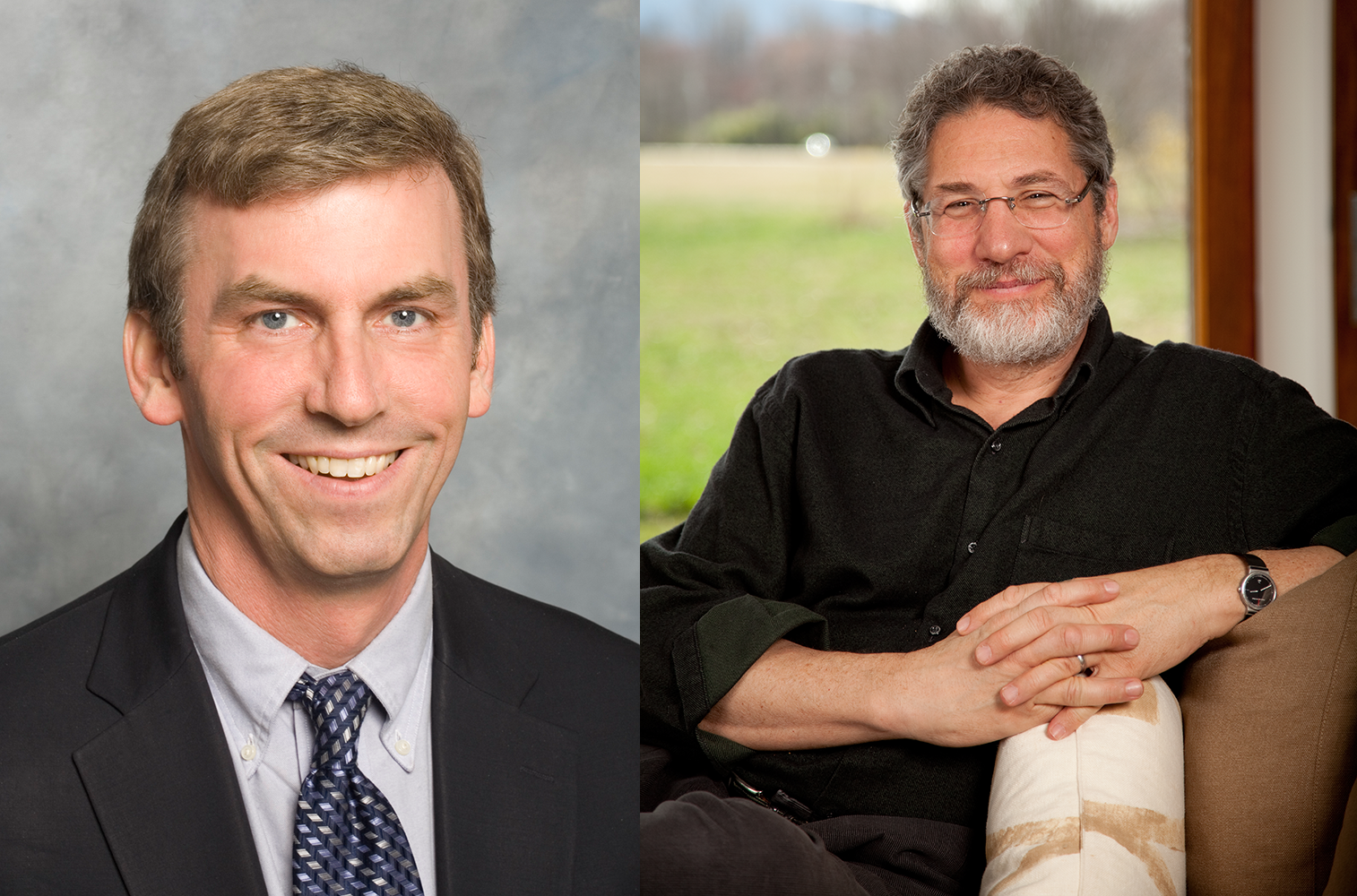
Via Verde was designed by Jonathan F.P. Rose (right) and Paul Freitag. (Photo: Courtesy of Jonathan Rose Companies)
ROSE: To questions like that I say, “The answer is urban.” If you go back to the very beginning of history and the reason why cities first emerged all over the world, they all emerged with a mission to actually create harmony between heaven and earth. They all grew up initially around a temple. A temple was always the first building in these very early cities, and the role was always somehow to harmonize these forces. And the role of their leaders was to harmonize these forces. Our cities again need to become the places that harmonize the forces of humans and nature to create happiness.
CURWOOD: Now the skeptics will say, “You can’t do that with steel and concrete.” And you would say?
ROSE: We have done it with steel and concrete! And we will continue, and we can only get better at it.
CURWOOD: Jonathan Rose is the Principal of the Jonathan Rose Companies. Thanks so much for taking this time.
ROSE: Thank you Steve, it’s a great pleasure talking with you.
Links
Visit the Via Verde project’s website.
Check out Jonathan Rose Companies’ website to see what else they have in store
Living on Earth wants to hear from you!
Living on Earth
62 Calef Highway, Suite 212
Lee, NH 03861
Telephone: 617-287-4121
E-mail: comments@loe.org
Newsletter [Click here]
Donate to Living on Earth!
Living on Earth is an independent media program and relies entirely on contributions from listeners and institutions supporting public service. Please donate now to preserve an independent environmental voice.
NewsletterLiving on Earth offers a weekly delivery of the show's rundown to your mailbox. Sign up for our newsletter today!
 Sailors For The Sea: Be the change you want to sea.
Sailors For The Sea: Be the change you want to sea.
 The Grantham Foundation for the Protection of the Environment: Committed to protecting and improving the health of the global environment.
The Grantham Foundation for the Protection of the Environment: Committed to protecting and improving the health of the global environment.
 Contribute to Living on Earth and receive, as our gift to you, an archival print of one of Mark Seth Lender's extraordinary wildlife photographs. Follow the link to see Mark's current collection of photographs.
Contribute to Living on Earth and receive, as our gift to you, an archival print of one of Mark Seth Lender's extraordinary wildlife photographs. Follow the link to see Mark's current collection of photographs.
 Buy a signed copy of Mark Seth Lender's book Smeagull the Seagull & support Living on Earth
Buy a signed copy of Mark Seth Lender's book Smeagull the Seagull & support Living on Earth

